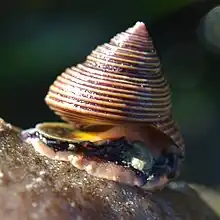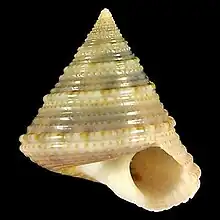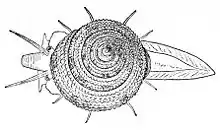Calliostoma
Calliostoma is a genus of small to medium-sized sea snails with gills and an operculum, marine gastropod molluscs within the family Calliostomatidae, the Calliostoma top snails. Previously this genus was placed within the family Trochidae. Calliostoma is the type genus of the family Calliostomatidae.
| Calliostoma | |
|---|---|
 | |
| A live individual of Calliostoma ligatum with the operculum showing at the back (on the left) | |
| Scientific classification | |
| Domain: | Eukaryota |
| Kingdom: | Animalia |
| Phylum: | Mollusca |
| Class: | Gastropoda |
| Subclass: | Vetigastropoda |
| Order: | Trochida |
| Superfamily: | Trochoidea |
| Family: | Calliostomatidae |
| Subfamily: | Calliostomatinae |
| Genus: | Calliostoma Swainson, 1840 |
| Type species | |
| Trochus conulus Linnaeus, 1758 | |
| Synonyms[1] | |
|
List
| |

Description
The name of this genus is derived from the Greek words kallos (beautiful) and stoma (mouth), referring to the pearly aperture of the shell. The genus Calliostoma is known in fossil records from the Upper Cretaceous onwards.[2]
The thin, acute, coeloconoid (=approaching conical shape but with concave sides) shell is imperforate or rarely umbilicate. The whorls are smooth, often polished and spirally ridged or granular. The body whorl is angulated at the periphery. The aperture is quadrangular, sinuated at the base and slightly oblique. The columella is simple, usually ending anteriorly in a slight tooth.[3] The nucleus appears to be either dextral or sinistral indifferently.[4][5]
Species
As of 2022, Calliostoma is treated as a very broad genus of about 300 accepted species.[6] While current information is too fragmentary to assign all species in a revised genus, it is expected to be broken up and (some) subgenera will be elevated to the status of genus.
Distribution and habitat
The distribution of this genus is worldwide, found mainly on hard substrates, although Japanese species have been found on sandy bottoms. These snails occur from shallow waters to bathyal depths.
Behaviour and ecology
The species in this genus are mainly herbivorous or feed on detritus,[7] although a few have been observed to be omnivorous (Keen, 1975) or even carnivorous, feeding on a wide range of algae and on animals belonging to various other invertebrate phyla.[8] The North Atlantic topshell Calliostoma occidentale has been reported to feed on coelenterates.[9]
Contrary to what is the case in most other top shells, species of the genus Calliostoma deposits their eggs in gelatinous ribbons that are only fertilized after being deposited. The young emerge as small snails (Lebour, 1936) without passing through a free-living planktonic stage as a veliger larva.
Gallery
 Drawing of a dorsal view of a living animal of Calliostoma bairdii dredged in the Atlantic Ocean at a depth of from 100 m to 1170 m
Drawing of a dorsal view of a living animal of Calliostoma bairdii dredged in the Atlantic Ocean at a depth of from 100 m to 1170 m Rare purple beaded specimen of Calliostoma supragranosum found subtidally in Southern California
Rare purple beaded specimen of Calliostoma supragranosum found subtidally in Southern California
References
- Calliostoma Swainson, 1840. Retrieved through: World Register of Marine Species on 30 October 2010.
- Shimer & Shrock (1944). Index fossils of North America.
- Tryon (1889), Manual of Conchology XI, Academy of Natural Sciences, Philadelphia
- Dall W. H. 1889. Reports on the results of dredging, under the supervision of Alexander Agassiz, in the Gulf of Mexico (1877–78) and in the Caribbean Sea (1879–80), by the U.S. Coast Survey Steamer "Blake", Lieut.-Commander C.D. Sigsbee, U.S.N., and Commander J.R. Bartlett, U.S.N., commanding. XXIX. Report on the Mollusca. Part 2, Gastropoda and Scaphopoda. Bulletin of the Museum of Comparative Zoölogy at Harvard College 18: 1–492, pls. 10–40
- Swainson, W. 1840. A treatise on malacology, or shells and shell-fish; London
- "WoRMS - World Register of Marine Species - Calliostoma Swainson, 1840". www.marinespecies.org. Retrieved 3 December 2022.
- Clench W. & Turner R. (1960). "The genus Calliostoma in the western Atlantic". Johnsonia 4(40) :1-80.
- Perron, F. E. (1975). "Carnivorous Calliostoma (Prosobranchia: Trochidae) from the northeastern Pacific". Veliger. 18: 52–54.
- Perron, Frank E.; Turner R. D. (1978). "The feeding behaviour and diet of Calliostoma occidentale, a coelenterate-associated prosobranch gastropod". Journal of Molluscan Studies. 44 (1): 100–103. Archived from the original on 15 April 2013. Retrieved 20 May 2010.
- Vilvens C. (2012) New species and new records of Seguenzioidea and Trochoidea (Gastropoda) from French Polynesia. Novapex 13(1): 1–23. [10 March 2012] page(s): 18
Further reading
- Marshall, B.A. (1995). "A revision of the recent Calliostoma species of New Zealand". The Nautilus. 108: 83–127.
- Quinn, J.F. Jr. (1992). "New species of Calliostoma and notes on some poorly known species from the Western Atlantic". The Nautilus. 106: 77–114.
- Rosenberg G. (2005). "Malacolog 4.1.0: : A database of Western Atlantic Marine Mollusca". Archived from the original on 24 September 2015. Retrieved 18 March 2009.
- Williams, S.T.; K.M. Donald; H.G. Spencer; T. Nakano (March 2010). "Molecular systematics of the marine gastropod families Trochidae and Calliostomatidae (Mollusca: Superfamily Trochoidea)". Molecular Phylogenetics and Evolution. 3. 54 (3): 783–809. doi:10.1016/j.ympev.2009.11.008. PMID 19919851.
- Vilvens C. (2009). New species and new records of Calliostomatidae (Gastropoda: Trochoidea) from New Caledonia and Solomon Islands. Novapex 10(4): 125-163